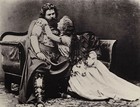
LIEBESTOD from 'Tristan und Isolde'
'LIEBESTOD' (LOVE-DEATH) IS THE TITLE OF THE FINAL, DRAMATIC ARIA FROM THE OPERA 'TRISTAN UND ISODLE', COMPOSED BY RICHARD WAGNER BETWEEN 1856-1859. THE OPERA AND SCORE HAVE OFTEN BEEN CITED AS LANDMARKS IN THE DEVELOPMENT OF WESTERN MUSIC.
highschool bands
jazz bands
college bands
all region bands
community bands
concert bands
honor bands
interlochen arts academy
marching bands
national music camp
tmea all state bands
university bands
Story behind the song
Liebestod (German, "Love death") is the title of the final, dramatic aria from the opera Tristan und Isolde by Richard Wagner. When used as a literary term, liebestod (from German Liebe, love and tod, death) refers to the theme of erotic death or "love death" meaning the two lovers' consummation of their love in death or after death.
Tristan und Isolde (Tristan and Isolde, or Tristan and Isolda) is an opera, or music drama, in three acts by Richard Wagner to a German libretto by the composer, based largely on the romance by Gottfried von Straßb.
Wagner's composition of Tristan und Isolde was inspired by his affair with Mathilde Wesendonck and the philosophy of Arthur Schopenhauer. Widely acknowledged as one of the peaks of the operatic repertory, Tristan was notable for Wagner's advanced use of chromaticism, tonality, orchestral colour and harmonic suspension.
The opera was profoundly influential amongst Western classical composers and provided inspiration to composers such as Gustav Mahler, Richard Strauss, Karol Szymanowski, Alban Berg and Arnold Schoenberg. Many see Tristan as the beginning of the move away from conventional harmony and tonality and consider that it lays the groundwork for the direction of classical musical in the 20th century.
The score of Tristan und Isolde has often been cited as a landmark in the development of Western music.
Wagner uses throughout Tristan a remarkable range of orchestral colour, harmony and polyphony and does so with a freedom rarely found in his earlier operas. The very first chord in the piece, the Tristan chord, is of great significance in the move away from traditional tonal harmony as it resolves to another dissonant chord.